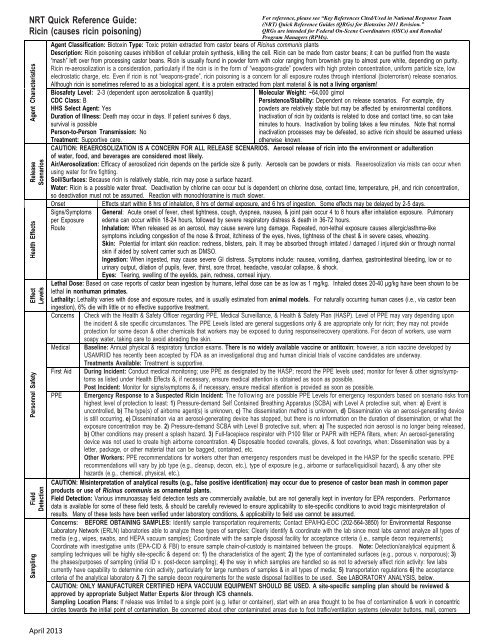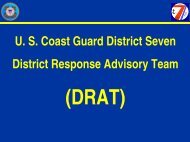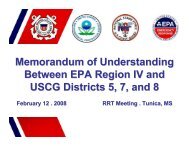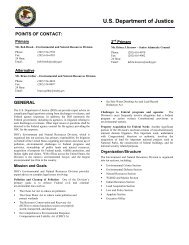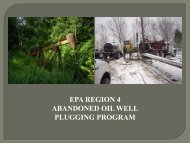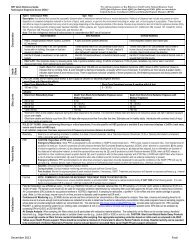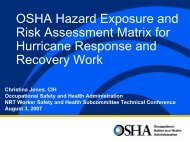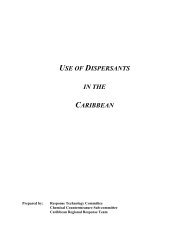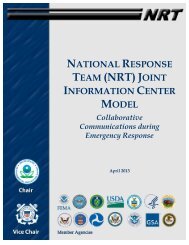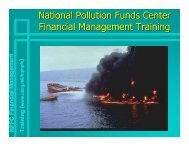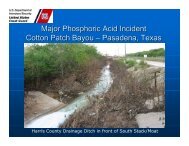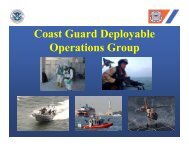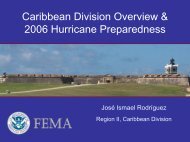Ricin poisoning - U.S. National Response Team (NRT)
Ricin poisoning - U.S. National Response Team (NRT)
Ricin poisoning - U.S. National Response Team (NRT)
Create successful ePaper yourself
Turn your PDF publications into a flip-book with our unique Google optimized e-Paper software.
SamplingFieldDetectionPersonnel SafetyEffectLevelsHealth EffectsReleaseScenariosAgent Characteristics<strong>NRT</strong> Quick Reference Guide:<strong>Ricin</strong> (causes ricin <strong>poisoning</strong>)April 2013For reference, please see “Key References Cited/Used in <strong>National</strong> <strong>Response</strong> <strong>Team</strong>(<strong>NRT</strong>) Quick Reference Guides (QRGs) for Biotoxins 2011 Revision.”QRGs are intended for Federal On-Scene Coordinators (OSCs) and RemedialProgram Managers (RPMs).Agent Classification: Biotoxin Type: Toxic protein extracted from castor beans of <strong>Ricin</strong>us communis plantsDescription: <strong>Ricin</strong> <strong>poisoning</strong> causes inhibition of cellular protein synthesis, killing the cell. <strong>Ricin</strong> can be made from castor beans; it can be purified from the waste“mash” left over from processing castor beans. <strong>Ricin</strong> is usually found in powder form with color ranging from brownish gray to almost pure white, depending on purity.<strong>Ricin</strong> re-aerosolization is a consideration, particularly if the ricin is in the form of “weapons-grade” powders with high protein concentration, uniform particle size, lowelectrostatic charge, etc. Even if ricin is not “weapons-grade”, ricin <strong>poisoning</strong> is a concern for all exposure routes through intentional (bioterrorism) release scenarios.Although ricin is sometimes referred to as a biological agent, it is a protein extracted from plant material & is not a living organism!Biosafety Level: 2-3 (dependent upon aerosolization & quantity)CDC Class: BHHS Select Agent: YesDuration of Illness: Death may occur in days. If patient survives 6 days,survival is possiblePerson-to-Person Transmission: NoTreatment: Supportive care.Molecular Weight: ~64,000 g/molPersistence/Stability: Dependent on release scenarios. For example, drypowders are relatively stable but may be affected by environmental conditions.Inactivation of ricin by oxidants is related to dose and contact time, so can takeminutes to hours. Inactivation by boiling takes a few minutes. Note that normalinactivation processes may be defeated, so active ricin should be assumed unlessotherwise known.CAUTION: REAEROSOLIZATION IS A CONCERN FOR ALL RELEASE SCENARIOS. Aerosol release of ricin into the environment or adulterationof water, food, and beverages are considered most likely.Air/Aerosolization: Efficacy of aerosolized ricin depends on the particle size & purity. Aerosols can be powders or mists. Reaerosolization via mists can occur whenusing water for fire fighting.Soil/Surfaces: Because ricin is relatively stable, ricin may pose a surface hazard.Water: <strong>Ricin</strong> is a possible water threat. Deactivation by chlorine can occur but is dependent on chlorine dose, contact time, temperature, pH, and ricin concentration,so deactivation must not be assumed. Reaction with monochloramine is much slower.OnsetSigns/Symptomsper ExposureRouteEffects start within 8 hrs of inhalation, 8 hrs of dermal exposure, and 6 hrs of ingestion. Some effects may be delayed by 2-5 days.General: Acute onset of fever, chest tightness, cough, dyspnea, nausea, & joint pain occur 4 to 8 hours after inhalation exposure. Pulmonaryedema can occur within 18-24 hours, followed by severe respiratory distress & death in 36-72 hours.Inhalation: When released as an aerosol, may cause severe lung damage. Repeated, non-lethal exposure causes allergic/asthma-likesymptoms including congestion of the nose & throat, itchiness of the eyes, hives, tightness of the chest & in severe cases, wheezing.Skin: Potential for irritant skin reaction: redness, blisters, pain. It may be absorbed through irritated / damaged / injured skin or through normalskin if aided by solvent carrier such as DMSO.Ingestion: When ingested, may cause severe GI distress. Symptoms include: nausea, vomiting, diarrhea, gastrointestinal bleeding, low or nourinary output, dilation of pupils, fever, thirst, sore throat, headache, vascular collapse, & shock.Eyes: Tearing, swelling of the eyelids, pain, redness, corneal injury.Lethal Dose: Based on case reports of castor bean ingestion by humans, lethal dose can be as low as 1 mg/kg. Inhaled doses 20-40 µg/kg have been shown to belethal in nonhuman primates.Lethality: Lethality varies with dose and exposure routes, and is usually estimated from animal models. For naturally occurring human cases (i.e., via castor beaningestion), 6% die with little or no effective supportive treatment.Concerns Check with the Health & Safety Officer regarding PPE, Medical Surveillance, & Health & Safety Plan (HASP). Level of PPE may vary depending uponthe incident & site specific circumstances. The PPE Levels listed are general suggestions only & are appropriate only for ricin; they may not provideprotection for some decon & other chemicals that workers may be exposed to during response/recovery operations. For decon of workers, use warmsoapy water, taking care to avoid abrading the skin.Medical Baseline: Annual physical & respiratory function exams. There is no widely available vaccine or antitoxin; however, a ricin vaccine developed byUSAMRIID has recently been accepted by FDA as an investigational drug and human clinicial trials of vaccine candidates are underway.Treatments Available: Treatment is supportive.First Aid During Incident: Conduct medical monitoring; use PPE as designated by the HASP; record the PPE levels used; monitor for fever & other signs/symptomsas listed under Health Effects &, if necessary, ensure medical attention is obtained as soon as possible.Post Incident: Monitor for signs/symptoms &, if necessary, ensure medical attention is provided as soon as possible.PPE Emergency <strong>Response</strong> to a Suspected <strong>Ricin</strong> Incident: The following are possible PPE Levels for emergency responders based on scenario risks fromhighest level of protection to least: 1) Pressure-demand Self Contained Breathing Apparatus (SCBA) with Level A protective suit, when: a) Event isuncontrolled, b) The type(s) of airborne agent(s) is unknown, c) The dissemination method is unknown, d) Dissemination via an aerosol-generating deviceis still occurring, e) Dissemination via an aerosol-generating device has stopped, but there is no information on the duration of dissemination, or what theexposure concentration may be. 2) Pressure-demand SCBA with Level B protective suit, when: a) The suspected ricin aerosol is no longer being released,b) Other conditions may present a splash hazard. 3) Full-facepiece respirator with P100 filter or PAPR with HEPA filters, when: An aerosol-generatingdevice was not used to create high airborne concentration. 4) Disposable hooded coveralls, gloves, & foot coverings, when: Dissemination was by aletter, package, or other material that can be bagged, contained, etc.Other Workers: PPE recommendations for workers other than emergency responders must be developed in the HASP for the specific scenario. PPErecommendations will vary by job type (e.g., cleanup, decon, etc.), type of exposure (e.g., airborne or surface/liquid/soil hazard), & any other sitehazards (e.g., chemical, physical, etc.).CAUTION: Misinterpretation of analytical results (e.g., false positive identification) may occur due to presence of castor bean mash in common paperproducts or use of <strong>Ricin</strong>us communis as ornamental plants.Field Detection: Various immunoassay field detection tests are commercially available, but are not generally kept in inventory for EPA responders. Performancedata is available for some of these field tests, & should be carefully reviewed to ensure applicability to site-specific conditions to avoid tragic misinterpretation ofresults. Many of these tests have been verified under laboratory conditions, & applicability to field use cannot be assumed.Concerns: BEFORE OBTAINING SAMPLES: Identify sample transportation requirements; Contact EPA/HQ-EOC (202-564-3850) for Environmental <strong>Response</strong>Laboratory Network (ERLN) laboratories able to analyze these types of samples; Clearly identify & coordinate with the lab since most labs cannot analyze all types ofmedia (e.g., wipes, swabs, and HEPA vacuum samples); Coordinate with the sample disposal facility for acceptance criteria (i.e., sample decon requirements);Coordinate with investigative units (EPA-CID & FBI) to ensure sample chain-of-custody is maintained between the groups. Note: Detection/analytical equipment &sampling techniques will be highly site-specific & depend on: 1) the characteristics of the agent; 2) the type of contaminated surfaces (e.g., porous v. nonporous); 3)the phases/purposes of sampling (initial ID v. post-decon sampling); 4) the way in which samples are handled so as not to adversely affect ricin activity: few labscurrently have capability to determine ricin activity, particularly for large numbers of samples & in all types of media; 5) transportation regulations 6) the acceptancecriteria of the analytical laboratory & 7) the sample decon requirements for the waste disposal facilities to be used. See LABORATORY ANALYSIS, below.CAUTION: ONLY MANUFACTURER CERTIFIED HEPA VACCUUM EQUIPMENT SHOULD BE USED. A site-specific sampling plan should be reviewed &approved by appropriate Subject Matter Experts &/or through ICS channels.Sampling Location Plans: If release was limited to a single point (e.g. letter or container), start with an area thought to be free of contamination & work in concentriccircles towards the initial point of contamination. Be concerned about other contaminated areas due to foot traffic/ventilation systems (elevator buttons, mail, corners
Waste DisposalDecontamination/CleanupLaboratoryAnalysisof hallways, baseboards, light switches, door knobs, etc). Based on site characteristics & laboratory capacity, sampling plan may be judgmental, probabilistic, or acombination thereof.Consult EPA/HQ-EOC at 202-564-3850 for ERLN laboratory contact information for personnel who can explain/describe the sampling procedure mostcompatible with their current analytical procedure. Note: While ricin can be detected long after the protein has been inactivated & might be of forensic interest,the presence of inactive ricin says little about the potential human health risk in the days following a release.Air: Collect air samples with gel filter or impinger. Refer to the manufacturer’s aseptic sampling methods, flow rates, & sampling times. Ensure that the appropriatepump is used for the selected sampling method.Water: Since ricin can persist in water; any potable water source should be sampled. If the potable water is chlorinated, the chlorine needs to be neutralizedimmediately with a sodium thiosulfate or other neutralizer at the concentration specified by the analytical laboratory being used prior to shipment. As chlorine levelscan vary substantially throughout a drinking water system, it is not always appropriate to assume that a sample is chlorinated based solely on a description of thewater treatment processes in use.Soil: For the localized areas where soil deposition of ricin is suspected to have occurred (i.e., aerosol or liquid droplets), a surface soil sample from a depth of lessthan 1 inch (2.54 cm) should be obtained from a non-vegetated area.Surfaces: 1) Wipe & Swab Sampling (for non-porous surfaces): Sterile macrofoam swabs moistened with a solution recommended by the ERLN laboratory. Do NOTuse dry wipes or swabs. 2) HEPA Vacuum Sampling (for both porous & non-porous surfaces): collect samples in a HEPA sock designed to fit into an inlet nozzle of aHEPA vacuum cleaner. This method is good for screening & determining the extent & location of contamination in large areas.Sample Packaging & Shipping: The packaging & shipping of samples are subject to strict regulations established by DOT, CDC, USPS, OSHA, & IATA. Contact thesample-receiving laboratory to determine if they have additional packaging, shipping or labeling requirements. Samples should be packaged in an air-tight container &kept at temperatures of 40-50°F (4-10°C). Ensure samples are not placed directly on the ice used for cooling the shipping container.CAUTION: Many labs may not be able to perform analysis on all matrices (e.g., wipes & soil). The ERLN will use uniform, compatible sample prep & analyticalmethods. (See http://www.epa.gov/sam). NOTE: The selected laboratory may use a tiered approach. If so, the initial analysis may only determine if select/particularcomponents of ricin are present in the sample (e.g., indicating presence or absence). It may take additional time (up to weeks depending on the laboratory) todetermine if ricin is active & still able to cause adverse effects.Laboratory Information: Contact EPA/HQ-EOC (202-564-3850) for contract laboratories able to analyze ricin samples.CAUTION: ONLY MANUFACTURER CERTIFIED HEPA VACUUM EQUIPMENT SHOULD BE USED.Decon Planning: Site-specific decon/cleanup plan should be developed & approved by all necessary organizations/SMEs via ICS channels. Responders shoulddevelop a plan that takes into account: 1) Nature of contamination including purity, physical properties, how it entered the facility, etc.; 2) Extent of contamination,including the amount & possible pathways that have spread the agent. It is advisable to isolate the contaminated area; & 3) Objectives of decon, including decon ofcritical items for re-use & the treatment, removal, or packaging of other items for disposal. Note: Crisis exemptions from EPA’s Office of Pesticide Programs are notneeded for decontaminating products (e.g. bleach) to denature a protein (e.g. ricin) unless the label on the product specifies its use as a disinfectant or pesticide.CAUTION: DECON SOLUTIONS SHOULD NOT BE DEPLOYED AS A SPRAY WHENEVER POSSIBLE.Decon Methods: As ricin is a protein, information from inactivation of other protein toxins (e.g. BoNT) may be useful when considering decon options. Decondecisions will be site & situation specific but due to re-aerosolization concerns, under NO circumstances should a non-HEPA vacuum cleaner or a broom beused. EPA’s <strong>National</strong> Decon <strong>Team</strong> (800-329-1841) can provide specific decontamination parameters & requirements for using readily available commercial itemssuch as household bleach. For large areas, low-tech cleanup methods most likely won’t be used – rather, widespread fumigation would be the most expedient & costeffective method selected. However, site specific fumigant application method is required. For small areas of contamination, discreet area decon methods wouldtypically proceed as follows: allow aerosols to settle & wear protective clothing; gently cover any contaminated areas with paper towel(s) (overlapping each other ifnecessary) & apply decon starting at the perimeter & wet towards the center of the contaminated area. Ensure sufficient contact time (e.g., 30 minutes) is provided &ensure the paper towel is kept “sopping” wet during this time. Remove the paper towel(s) then wipe up the residual dampness/drops of decon solution until surface isdry. Reapply decon solution to the bare surface & wipe up again with more paper towel(s) then let surface air dry. All contaminated decon materials (e.g., papertowels, etc.) should be labeled & discarded as hazardous waste.Methods used on surfaces: 1) Source reduction steps, including HEPA vacuuming; 2) Liquid decon solutions such as pH-amended bleach (mixture of 1 parthousehold bleach (5.25% to 6.0%) to 1 part white vinegar to 8 parts water is recommended). This product affects surfaces differently in terms of corrosiveness,staining, & residue. The product will be most efficient a) at higher temperatures (i.e., >70°F or 21°C), b) when plain bleach (e.g., no added fragrance) is used to makethe pH-amended bleach solution, c) when pH is < 7, d) when presence of other surface contaminants is minimal, & e) when surfaces remain wet with amendedbleach solution for at least 30 minutes. pH-amended bleach can be deployed as a liquid. Note: Store-bought bleach does degrade with time – check the expirationdate. For hard surfaces including floors (with attention to base boards & molding), walls, & horizontal surfaces of furniture & equipment, a 30-minute contact time isrecommended. Smaller items should be removed & treated with decon solution. Soft surfaces can be treated with decon solutions & then removed (e.g. carpeting cutup & double bagged).Thermal Inactivation. <strong>Ricin</strong> can be inactivated by 24 hours at 80% relative humidity & 200 o F (93 o C). It is possible that results could be achieved with highertemperatures for shorter periods of time. This combination of moisture & heat appears to be more effective than dry heat alone. It is important to evenly space allcontainers undergoing treatment for an even distribution of heat. In water, ricin may be deactivated after 30 min at 80 o C or a few minutes of boiling.Fumigation: Can decontaminate facilities in which there is evidence of high levels of contamination, re-aerosolization, or if decontamination of limited access areas isrequired (e.g. HVAC systems). Fumigant: Chlorine dioxide at 500 ppm with a contact time of 20 minutes, relative humidity of 80%, and temperature of 25°C hasbeen shown to effectively decon ricin on various building materials.Verification of Decon: Site and situation specific. Please contact U.S. EPA, Environmental <strong>Response</strong> <strong>Team</strong> (ERT) (732-321-6660) for further assistance.CAUTION: Hazardous waste transportation & disposal are regulated federally; however more stringent regulations may exist under state authority. These regulationsdiffer from state-to-state. Detailed state regulations can be found at www.envcap.org.Waste Disposal Planning: Waste generated from assessment & cleanup activities should be autoclaved, chemically disinfected, or fumigated & then tested to besure the agent(s) were inactivated. Waste disposal for agent-contaminated wastes generated from the decontamination & disposal activities will be problematic.Landfills willing to take these wastes may be limited & incineration may be prohibitively expensive or impractical. All waste disposal options should be investigated asearly into the response process as possible. Transportation of the agent contaminated wastes from the site to the landfill or incinerator may be problematic as well.First, agreements must be reached between the waste sender & acceptor BEFORE transport, followed by timely public notification of the transport & disposal phases.Transportation of hazardous waste may cross several states and localities, which may exceed federal regulations. Requirements for transporting hazardousmaterials, & procedure for exemption, are specified in http://www.fmcsa.dot.gov/safety-security/hazmat/complyhmregs.htm#hmp. <strong>Ricin</strong> is shipped as Hazard Zone A.The U.S. EPA has developed a web-based Incident Waste Management Planning & <strong>Response</strong> Tool which contains guidance related to waste transportation, contactinformation for potential treatment, disposal facilities & state regulatory offices, packaging guidance to minimize risk to workers, & guidance to minimize the potentialfor contaminating the treatment or disposal facility. Access to EPA’s web-based disposal tool requires pre-registration (http://www2.ergweb.com/bdrtool/login.asp).April 2013


